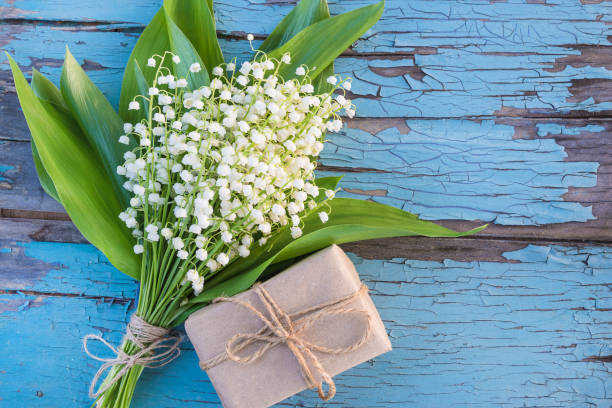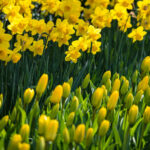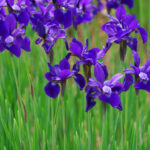Lily of the Valley (Convallaria majalis) is a delicate, fragrant perennial that has captivated gardeners and floral enthusiasts for centuries. With its petite bell-shaped flowers and sweet aroma, this low-growing plant has become a favorite in gardens, floral arrangements, and even symbolic cultural traditions worldwide. Native to Europe, parts of Asia, and North America, Lily of the Valley is widely appreciated not only for its beauty but also for its rich history of symbolism, medicinal use, and associations with luck and happiness.
In this detailed exploration, we’ll uncover everything you need to know about Lily of the Valley, from its characteristics and growing conditions to its care, symbolism, and role in different traditions.
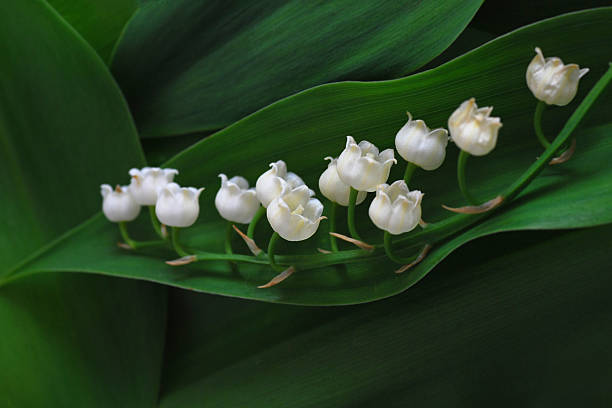

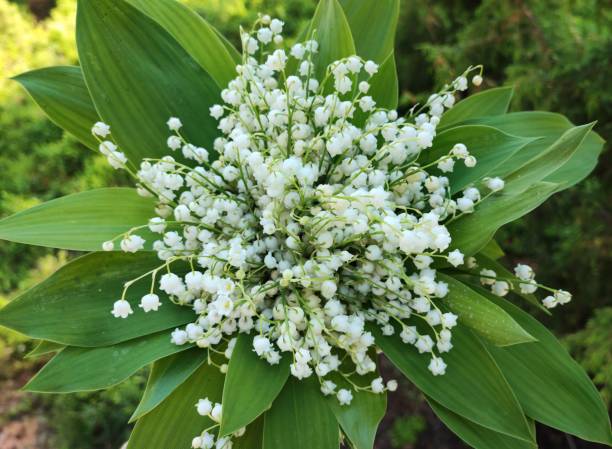
1. Botanical Overview of Lily of the Valley
Lily of the Valley is a member of the Asparagaceae family, which includes plants like asparagus and agave. Despite its common name, it is not a true lily but shares some aesthetic qualities with the lily family. The plant’s scientific name, Convallaria majalis, translates to “valley plant” and “belonging to May,” reflecting its preferred habitat in shaded valleys and its peak blooming time in May.
Key Characteristics:
- Plant Type: Perennial
- Height: 6 to 12 inches (15 to 30 cm)
- Flowers: Small, white, bell-shaped flowers that hang in clusters on slender stalks
- Foliage: Lance-shaped green leaves that form a lush, low-growing mat
- Fragrance: Sweet and intense, often described as floral and fresh
- Blooming Time: Late spring to early summer (primarily May)
Lily of the Valley is often used as ground cover due to its spreading nature. It reproduces via rhizomes, underground stems that extend outward, allowing the plant to form dense colonies over time. While the white-flowered variety is the most common, there are also pink-flowered varieties, though they are less frequently seen.
2. Growing and Caring for Lily of the Valley
Lily of the Valley is relatively easy to grow and maintain, making it a favorite for gardeners looking to add charm to shady areas of their garden. Its low-growing nature and ability to spread quickly make it ideal for borders, woodland gardens, or as a ground cover under trees.
a. Planting Location and Soil
Lily of the Valley thrives in cool, shaded environments, much like the dappled light found in forested areas. It prefers partial to full shade, which makes it an excellent plant for spots that receive little direct sunlight.
- Light: Partial to full shade
- Soil: Rich, well-drained soil with a neutral to slightly acidic pH. Adding organic matter like compost can help improve the quality of the soil and provide nutrients for the plant.
- Moisture: Lily of the Valley prefers consistently moist soil but does not tolerate waterlogged conditions. It’s important to plant it in an area where water drains well.
b. Planting Lily of the Valley
Lily of the Valley is typically planted from rhizomes, which are available in nurseries and garden centers. These rhizomes, often called “pips,” are usually planted in the fall or early spring, allowing the plant time to establish before its growing season.
- Planting Depth: Plant the pips about 1 to 2 inches deep, with the pointed end facing upward.
- Spacing: Space the pips about 6 to 12 inches apart to allow for spreading. Over time, the plant will naturally fill in gaps and create a lush carpet of foliage and flowers.
c. Care and Maintenance
Lily of the Valley is a low-maintenance plant once it’s established, but it does require some basic care to keep it healthy and thriving.
- Watering: Keep the soil consistently moist, especially during dry periods, but avoid overwatering. Too much water can cause the roots to rot.
- Fertilizing: Lily of the Valley does not need heavy fertilization. A light application of compost or an all-purpose fertilizer in early spring can encourage healthy growth.
- Mulching: Mulching around the base of the plant can help retain soil moisture, regulate temperature, and suppress weeds.
d. Dividing and Propagating
Lily of the Valley tends to spread quickly via its rhizomes. If it becomes overcrowded or you wish to propagate it to other areas of your garden, you can divide the plants in the fall.
- Carefully dig up the clumps, being careful not to damage the rhizomes.
- Separate the clumps into smaller sections, each with its own roots and shoots.
- Replant the divisions in a new location, following the same planting instructions as before.
e. Potential Problems
Lily of the Valley is relatively pest-resistant, but it can sometimes suffer from fungal diseases, especially in overly damp conditions.
- Fungal Diseases: Ensure good air circulation around the plant and avoid overhead watering to prevent diseases like leaf spot and root rot.
- Pests: Occasionally, slugs and snails may feast on the leaves, especially in moist environments. Use organic slug bait or create barriers to protect the plants.
3. Symbolism and Cultural Significance of Lily of the Valley
Lily of the Valley is not only admired for its beauty and fragrance but also holds deep symbolic meaning across cultures. It is a flower steeped in tradition, often associated with purity, renewal, and happiness.
a. Symbol of Purity and Humility
In the Christian tradition, Lily of the Valley is often linked to the Virgin Mary, symbolizing her purity and humility. Its pristine white flowers and modest stature embody the ideals of simplicity and grace. The flower is sometimes referred to as “Our Lady’s Tears” because, according to legend, it grew from the tears the Virgin Mary shed at the foot of the cross.
b. Good Luck and Happiness
In many European cultures, particularly in France, the Lily of the Valley is considered a symbol of good luck and happiness. It is customary to give small bouquets of the flower on May 1st, a tradition known as “La Fête du Muguet” or “May Day.” This gesture is meant to bring good fortune and joy for the rest of the year.
c. Weddings and Royal Connections
Lily of the Valley is a popular choice for bridal bouquets, especially for brides who want a classic, elegant look. The flower is associated with love, devotion, and happiness, making it a fitting choice for weddings. Perhaps the most famous use of Lily of the Valley in a wedding bouquet was by Princess Grace Kelly, who carried the flower when she married Prince Rainier III of Monaco in 1956.
d. May Birth Flower
Lily of the Valley is the birth flower for May, symbolizing sweetness and renewed happiness. It’s a popular gift for those born in this month, representing the arrival of spring and the promise of new beginnings.
4. Lily of the Valley in Folklore and Mythology
Lily of the Valley has been featured in many myths and legends throughout history. In some stories, the flower is believed to bring protection and good fortune, while in others, it is associated with the mystical and divine.
- Christian Legend: According to Christian tradition, Lily of the Valley grew from the tears of the Virgin Mary as she wept for Jesus during the crucifixion. This association with Mary’s tears has led to the flower being used in religious ceremonies and depicted in Christian art.
- Roman Mythology: In Roman mythology, the flower is linked to the goddess Maia, who represents the earth’s fertility and the arrival of spring. The month of May, named after her, is when the Lily of the Valley typically blooms, further solidifying its connection to renewal and growth.
5. Uses of Lily of the Valley in Medicine and Perfumery
Lily of the Valley has been used in traditional medicine for centuries, though it is important to note that the plant is highly toxic and should only be used under professional guidance. In small doses, extracts from the plant have been used to treat heart conditions and improve circulation.
a. Medicinal Uses
Historically, Lily of the Valley was used to treat ailments like heart disease, epilepsy, and kidney issues. The plant contains cardiac glycosides, compounds that affect the heart’s rhythm. However, because all parts of the plant are toxic, it is rarely used in modern herbal medicine.
b. Perfumery
The enchanting fragrance of Lily of the Valley has made it a popular choice for perfumes and scented products. Its sweet, fresh scent is often described as light and floral, making it a beloved ingredient in many luxury fragrances. Due to the difficulty of extracting the scent from the actual flowers, most perfumes use synthetic versions of Lily of the Valley’s fragrance.
6. Caution: Toxicity of Lily of the Valley
While Lily of the Valley is a beautiful and fragrant plant, it is essential to remember that all parts of the plant are highly toxic if ingested. The plant contains compounds that can cause severe heart problems, nausea, vomiting, and even death if consumed. It is important to plant Lily of the Valley in areas where pets and children are unlikely to come into contact with it.
Conclusion
Lily of the Valley is a captivating flower that brings both beauty and a sense of history to any garden. Its delicate white blooms and sweet fragrance have made it a beloved plant for centuries, symbolizing purity, love, and happiness. With proper care, this perennial plant can thrive in shady garden spots, providing a lush ground cover and an enchanting springtime display. However, its toxicity requires caution, making it a plant to admire from a safe distance. Whether you’re planting it for its aesthetic value or its rich symbolism, Lily of the Valley is a flower that leaves a lasting impression.

